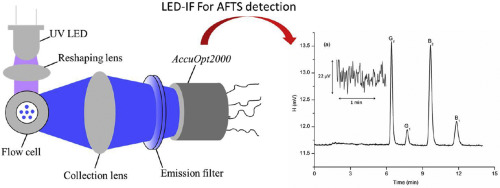当前位置:
X-MOL 学术
›
Anal. Chim. Acta
›
论文详情
Our official English website, www.x-mol.net, welcomes your feedback! (Note: you will need to create a separate account there.)
A novel HPLC flow cell integrated UV light emitting diode induced fluorescence detector as alternative for sensitive determination of aflatoxins
Analytica Chimica Acta ( IF 6.2 ) Pub Date : 2018-11-01 , DOI: 10.1016/j.aca.2018.06.059 Xuhui Geng , Nan Wang , Yan Gao , Haijing Ning , Yafeng Guan
Analytica Chimica Acta ( IF 6.2 ) Pub Date : 2018-11-01 , DOI: 10.1016/j.aca.2018.06.059 Xuhui Geng , Nan Wang , Yan Gao , Haijing Ning , Yafeng Guan

|
A novel UV light emitting diode induced fluorescence detector (LED-IF) with HPLC flow cell was designed and evaluated for determination of aflatoxins. Ray tracing method was employed to optimize the design of the optical components (such as reshaping thin lens for light source and fluorescence collection), and optical structure, and the geometry of flow cell. An ordinary UV LED with wavelength of 370 nm and radiant power of 5 mW was used as excitation light source. A photoelectric amplifier AccuOpt2000 with light sensitivity of 10-5∼10-4lx was utilized for fluorescence detection, instead of a photo multiplier tube (PMT). The lowest detection limit (LOD) of the LED-IF was 0.077 ppb for aflatoxin B1 by HPLC method without derivatization. The LED-IF was then coupled with a homemade iodine derivatization device, which was connected to the HPLC column outlet for determination of aflatoxins in edible oil and peanut samples. It was found that the edible oil sample contained aflatoxin B1 and B2 at average level of 7.14 (n = 3) and 0.30 ng/g (n = 3), respectively; while the peanut sample contained aflatoxin B1 and B2 at average level of 9.22 (n = 3) and 1.36 ng/g (n = 3), respectively. The overall power consumption of the LED-IF was 1 W/12 V. The sensitivity of the LED-IF was similar to commercial fluorescence detectors, which utilized a pulse Xe lamp as excitation light source and a PMT for detection, with power consumption of 150 W.
中文翻译:

一种新型 HPLC 流通池集成紫外发光二极管诱导荧光检测器,可作为黄曲霉毒素灵敏测定的替代方案
设计并评估了一种具有 HPLC 流通池的新型紫外发光二极管诱导荧光检测器 (LED-IF),用于测定黄曲霉毒素。采用光线追踪方法优化光学元件的设计(如为光源和荧光收集重塑薄透镜)、光学结构和流动池的几何形状。使用波长为 370 nm、辐射功率为 5 mW 的普通 UV LED 作为激发光源。使用光敏度为 10-5∼10-4lx 的光电放大器 AccuOpt2000 代替光电倍增管 (PMT) 进行荧光检测。LED-IF 的最低检测限 (LOD) 是黄曲霉毒素 B1 的 0.077 ppb,通过 HPLC 方法无需衍生化。然后将 LED-IF 与自制的碘衍生装置耦合,与 HPLC 色谱柱出口相连,用于测定食用油和花生样品中的黄曲霉毒素。发现食用油样品中黄曲霉毒素B1和B2的平均含量分别为7.14(n=3)和0.30ng/g(n=3);而花生样品中黄曲霉毒素 B1 和 B2 的平均水平分别为 9.22 (n = 3) 和 1.36 ng/g (n = 3)。LED-IF 的总功耗为 1 W/12 V。 LED-IF 的灵敏度与商用荧光检测器相似,使用脉冲氙灯作为激发光源,使用 PMT 进行检测,功耗为150 瓦。而花生样品中黄曲霉毒素 B1 和 B2 的平均水平分别为 9.22 (n = 3) 和 1.36 ng/g (n = 3)。LED-IF 的总功耗为 1 W/12 V。 LED-IF 的灵敏度与商用荧光检测器相似,使用脉冲氙灯作为激发光源,使用 PMT 进行检测,功耗为150 瓦。而花生样品中黄曲霉毒素 B1 和 B2 的平均水平分别为 9.22 (n = 3) 和 1.36 ng/g (n = 3)。LED-IF 的总功耗为 1 W/12 V。 LED-IF 的灵敏度与商用荧光检测器相似,使用脉冲氙灯作为激发光源,使用 PMT 进行检测,功耗为150 瓦。
更新日期:2018-11-01
中文翻译:

一种新型 HPLC 流通池集成紫外发光二极管诱导荧光检测器,可作为黄曲霉毒素灵敏测定的替代方案
设计并评估了一种具有 HPLC 流通池的新型紫外发光二极管诱导荧光检测器 (LED-IF),用于测定黄曲霉毒素。采用光线追踪方法优化光学元件的设计(如为光源和荧光收集重塑薄透镜)、光学结构和流动池的几何形状。使用波长为 370 nm、辐射功率为 5 mW 的普通 UV LED 作为激发光源。使用光敏度为 10-5∼10-4lx 的光电放大器 AccuOpt2000 代替光电倍增管 (PMT) 进行荧光检测。LED-IF 的最低检测限 (LOD) 是黄曲霉毒素 B1 的 0.077 ppb,通过 HPLC 方法无需衍生化。然后将 LED-IF 与自制的碘衍生装置耦合,与 HPLC 色谱柱出口相连,用于测定食用油和花生样品中的黄曲霉毒素。发现食用油样品中黄曲霉毒素B1和B2的平均含量分别为7.14(n=3)和0.30ng/g(n=3);而花生样品中黄曲霉毒素 B1 和 B2 的平均水平分别为 9.22 (n = 3) 和 1.36 ng/g (n = 3)。LED-IF 的总功耗为 1 W/12 V。 LED-IF 的灵敏度与商用荧光检测器相似,使用脉冲氙灯作为激发光源,使用 PMT 进行检测,功耗为150 瓦。而花生样品中黄曲霉毒素 B1 和 B2 的平均水平分别为 9.22 (n = 3) 和 1.36 ng/g (n = 3)。LED-IF 的总功耗为 1 W/12 V。 LED-IF 的灵敏度与商用荧光检测器相似,使用脉冲氙灯作为激发光源,使用 PMT 进行检测,功耗为150 瓦。而花生样品中黄曲霉毒素 B1 和 B2 的平均水平分别为 9.22 (n = 3) 和 1.36 ng/g (n = 3)。LED-IF 的总功耗为 1 W/12 V。 LED-IF 的灵敏度与商用荧光检测器相似,使用脉冲氙灯作为激发光源,使用 PMT 进行检测,功耗为150 瓦。



























 京公网安备 11010802027423号
京公网安备 11010802027423号